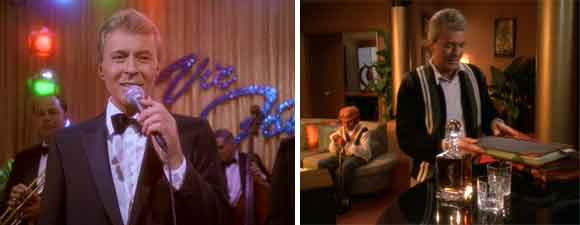Retro Review: It’s Only a Paper Moon
6 min readAfter losing his leg in the siege of AR-558, Nog prefers life on the holodeck to facing his fellow officers and friends.
Plot Summary: Weeks after receiving an artificial leg, Nog returns to the station limping and in pain, though Starfleet doctors have told him that the discomfort is psychological. At first Dax is sympathetic to his complaint that he’s had to talk about his feelings too much and advises Rom and Jake to treat him normally, but when Jake tells Nog that he can’t listen to Vic Fontaine singing “I’ll Be Seeing You” one more time, Nog goes to the holosuite to have Vic sing it for him there. Admitting that he isn’t able to cope with Starfleet and his family, Nog asks Vic whether he can rehabilitate himself within the historic Las Vegas scenario. Though Nog gets along well with Vic and other holograms in the program, helping Vic make plans for a new casino, the Ferengi is hostile to Jake when Jake brings a date to the holodeck and resists Dax’s suggestions that it’s time to return to his real life. Though Vic is reluctant to let Nog go after experiencing “real life” during several weeks of continuous activation, the hologram concludes that Dax is right, telling Nog not to live in an illusion, then turning himself off so that Nog will be forced to leave the holosuite. Once O’Brien has persuaded Nog that he can’t reactivate the program without the self-aware Vic’s approval, Nog gives up manipulating the controls and Vic appears once more, getting Nog to admit that he’s terrified of the suffering he experienced during the war. Vic persuades Nog that if he remains in a holosuite, he will die even more surely than in battle, persuading the young officer to rejoin his family and return to work. No longer dependent on the cane, Nog returns to limited duty and later thanks Vic by persuading Quark to leave the holosuite program running at all times so that Vic, too, can continue to experience a real life.
Analysis: The first time I reviewed this episode, I was focused on it as an installment in Star Trek’s ongoing love affair with holograms – a story about Vic’s sentience and the temptations of fantasy life over real life. I can’t believe I spent so little time talking about the powerful story of a disabled veteran’s experience. It’s a bit slow to start, and in some ways a bit cliched, though maybe that’s necessary to make Nog into a representative of every soldier, not specifically a Ferengi in the Dominion War. It builds its power by not focusing overmuch on the details of his injuries and his sense upon returning that nothing in the universe can be counted upon, instead making his experiences in the holosuite as real to him as they are to viewers and therefore as hard to lose. We’ve seen a lot of characters mourning lost friends and fellow officers, yet Nog is the first wounded warrior whose life receives any in-depth attention. You’d think that, after his experience in “Nor the Battle to the Strong” facing his own terrors, Jake would understand Nog better – he should give Nog a copy of that story he gave his father – and that Ezri, who’s still processing the trauma of Jadzia’s death, might be able to open up a bit more about her own memories of brutal assault instead of insisting on a counselor’s professionalism, but part of the point is that not even people who care about Nog’s feelings have a clue how to help him work through them. Even with the wonders of 24th century medicine, I find it hard to believe that doctors would expect Nog to feel physically perfect so quickly and would tell him his pain was all in his head. We know enough now about how trauma affects the brain to understand that neurons keep firing even when the traumatic stimulus has been removed. Because of the war, they’re probably in a hurry to move personnel through and back to duty, but it’s appalling to think that so far in the future, there will still be so few avenues available for wounded soldiers to receive support.
When it becomes apparent that Nog is more comfortable living and working in 20th century Las Vegas, it’s a little odd that Dax and the others don’t attempt to approach Nog from within that venue to draw him back out – surely Quark has business propositions that have nothing to do with the war in which he could involve Nog the same way Vic gets Nog excited about his accounting problems, and surely Rom has some side engineering projects since he often seems to be working on some problem beyond what Starfleet and his brother require. It seems that they’re all ready to let Nog work out his own therapy because they’re rather clueless and not doing any research to improve their knowledge. Dax announcing to Vic that he’s a hologram so she outranks him sounds particularly pathetic, but grumbling Quark and head-shaking Sisko aren’t any more equipped to offer substantive advice, and you’d think that Bashir might join the fantasy whose parameters he helped to create for long enough to see whether he might help a patient on his own terms. Before “It’s Only a Paper Moon,” Nog has always seemed to have Quark’s cynical sense of the value of holosuites, which the other Trek shows have made clear are most often used for gratification – often sexual, sometimes sporting – and frequently become as a source of ridicule, whether it’s teasing Bashir for his spy programs or treating Reg Barclay with revulsion for his crew-driven fantasies (even if it’s also shown to be completely normal for Will Riker to have a hot holographic woman appreciating his musical skills and for Kathryn Janeway to have a burly lord kissing her while playing out a Victorian holonovel in which she must know what’s coming).
Vic is as sentient as Voyager’s emergency medical hologram, and if his career seems less significant than that of a Starfleet officer, it’s worth pointing out that entertainment of the type he provides has been a component of USO shows since before Vic’s own era, considered important for morale. I wonder whether listening to “I’ll Be Seeing You” is not really comforting Nog, but subconsciously reinforcing the suffering and helplessness he experienced when the song first distracted him in Bashir’s makeshift triage unit during the battle. It’s a good vehicle to get Nog to Vic’s, since a Ferengi engineer and a holographic old-Earth human would seem to have little in common – the fact that they don’t know each other except by hearsay makes that clear. Does it matter that Vic’s not human any more than it mattered that Moriarty wasn’t human when facing off against Data? It seems as if it shouldn’t. Barclay’s ridicule in “Hollow Pursuits” has always struck me as a swipe at fans who’d rather cosplay and go to conventions than learn to be good little officers, so it’s a pleasure to get an episode in which a holosuite becomes a valuable therapeutic tool, yet in the end, we’re told to dismiss Vic as phony, even though he’s the only one to whom Nog can confess his feeling that he can’t go back into the situation that led to his suffering. That Nog recovers so quickly after Vic boots him serves the drama not because it’s what Nog needs – what Nog really needs all along is more balance – but because the isolation is what Vic needs after a taste of real life. As Aron Eisenberg and James Darren play off one another, there’s a shift from the holographic mentor helping a scared kid to the Starfleet officer reaching out to a trapped hologram. Vic may lack the existential angst of Moriarty or the EMH, since he’s programmed not to let things get too heavy, but the fundamental unhappiness of having no control over his life parallels Nog’s situation a little too well.






